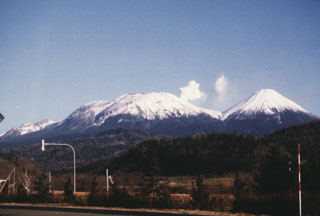Report on Akan (Japan) — October 1992
Bulletin of the Global Volcanism Network, vol. 17, no. 10 (October 1992)
Managing Editor: Lindsay McClelland.
Akan (Japan) Seismic activity resumes but gas emission unchanged
Please cite this report as:
Global Volcanism Program, 1992. Report on Akan (Japan) (McClelland, L., ed.). Bulletin of the Global Volcanism Network, 17:10. Smithsonian Institution. https://doi.org/10.5479/si.GVP.BGVN199210-285070
Akan
Japan
43.384°N, 144.013°E; summit elev. 1499 m
All times are local (unless otherwise noted)
Seismic activity increased from 22 September, peaking at 186 earthquakes/day on 2 October (17:9). Seismicity then gradually declined to background levels of 1/day by 10 October. Activity resumed on 27 October with 10-20 events/day continuing through mid-November. None of the earthquakes were felt. Epicenters for the earthquakes were presumed to be at or near the active crater. Surface activity remained unchanged, with white steam rising to a few hundred meters.
Geological Summary. Akan is a 13 x 24 km caldera located immediately SW of Kussharo caldera in eastern Hokkaido. The elongated, irregular outline of the caldera rim reflects its incremental formation during major explosive eruptions from the early to mid-Pleistocene. There are four post-caldera stratovolcanoes, three at the SW end of the caldera and the other on the NE side. Conical Oakandake was frequently active during the Holocene. The 1-km-wide Nakamachineshiri crater of Meakandake was formed during a major pumice-and-scoria eruption about 13,500 years ago. The Meakandake group, composed of nine overlapping cones E of Lake Akan, has produced mild phreatic eruptions since the beginning of the 19th century. The main cone of Meakandake proper has a triple crater at its summit. Although recorded eruptions at Meakandake have consisted of minor phreatic explosions, four major magmatic eruptions with pyroclastic flows have also occurred during the Holocene.
Information Contacts: JMA.

